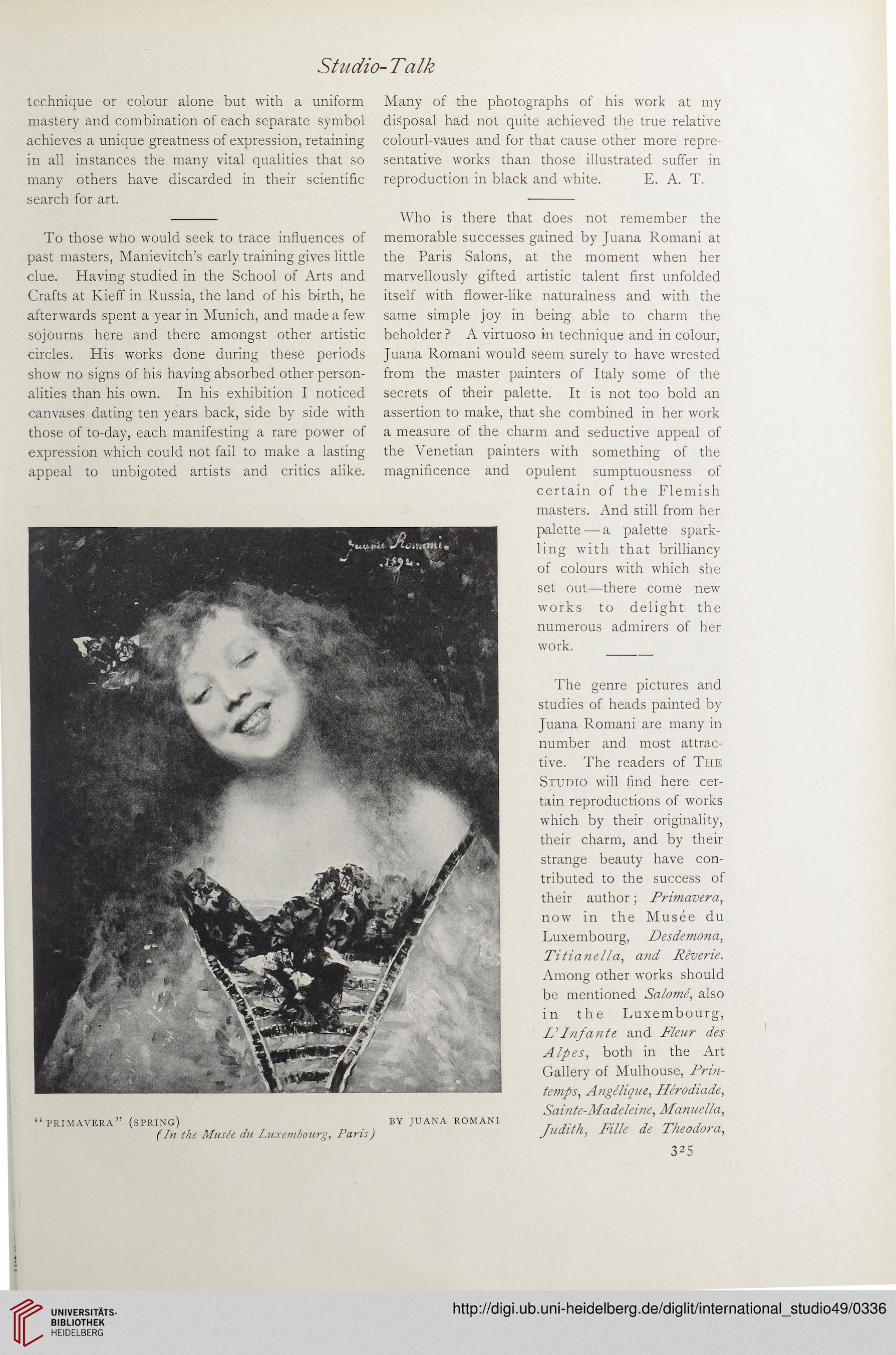Studio-Talk
technique or colour alone but with a uniform
mastery and combination of each separate symbol
achieves a unique greatness of expression, retaining
in all instances the many vital qualities that so
many others have discarded in their scientific
search for art.
Many of the photographs of his work at my
disposal had not quite achieved the true relative
colourl-vaues and for that cause other more repre-
sentative works than those illustrated suffer in
reproduction in black and white. E. A. T.
Who is there that does not remember the
To those who would seek to trace influences of
past masters, Manievitch’s early training gives little
clue. Having studied in the School of Arts and
Crafts at Kieff in Russia, the land of his birth, he
afterwards spent a year in Munich, and made a few
sojourns here and there amongst other artistic
circles. His works done during these periods
show no signs of his having absorbed other person-
alities than his own. In his exhibition I noticed
canvases dating ten years back, side by side with
those of to-day, each manifesting a rare power of
expression which could not fail to make a lasting
appeal to unbigoted artists and critics alike.
memorable successes gained by Juana Romani at
the Paris Salons, at the moment when her
marvellously gifted artistic talent first unfolded
itself with flower-like naturalness and with the
same simple joy in being able to charm the
beholder ? A virtuoso in technique and in colour,
Juana Romani would seem surely to have wrested
from the master painters of Italy some of the
secrets of their palette. It is not too bold an
assertion to make, that she combined in her work
a measure of the charm and seductive appeal of
the Venetian painters with something of the
magnificence and opulent sumptuousness of
certain of the Flemish
masters. And still from her
“PRIMAVERA” (spring) by JUANA ROMANI
(In the Musee chi Luxembourg, Paris)
palette — a palette spark-
ling with that brilliancy
of colours with which she
set out—there come new
works to delight the
numerous admirers of her
work.
The genre pictures and
studies of heads painted by
Juana Romani are many in
number and most attrac-
tive. The readers of The
Studio will find here cer-
tain reproductions of works
which by their originality,
their charm, and by their
strange beauty have con-
tributed to the success of
their author; Primavera,
now in the Musee du
Luxembourg, Desdemona,
Titianella, and Reverie.
Among other works should
be mentioned Salome, also
in the Luxembourg,
D Inf ante and Fleur des
Alpes, both in the Art
Gallery of Mulhouse, Prin-
temps, Angelique, Herodiade,
Sainte-Madeleine, Manuella,
Judith, Fille de Theodora,
325
technique or colour alone but with a uniform
mastery and combination of each separate symbol
achieves a unique greatness of expression, retaining
in all instances the many vital qualities that so
many others have discarded in their scientific
search for art.
Many of the photographs of his work at my
disposal had not quite achieved the true relative
colourl-vaues and for that cause other more repre-
sentative works than those illustrated suffer in
reproduction in black and white. E. A. T.
Who is there that does not remember the
To those who would seek to trace influences of
past masters, Manievitch’s early training gives little
clue. Having studied in the School of Arts and
Crafts at Kieff in Russia, the land of his birth, he
afterwards spent a year in Munich, and made a few
sojourns here and there amongst other artistic
circles. His works done during these periods
show no signs of his having absorbed other person-
alities than his own. In his exhibition I noticed
canvases dating ten years back, side by side with
those of to-day, each manifesting a rare power of
expression which could not fail to make a lasting
appeal to unbigoted artists and critics alike.
memorable successes gained by Juana Romani at
the Paris Salons, at the moment when her
marvellously gifted artistic talent first unfolded
itself with flower-like naturalness and with the
same simple joy in being able to charm the
beholder ? A virtuoso in technique and in colour,
Juana Romani would seem surely to have wrested
from the master painters of Italy some of the
secrets of their palette. It is not too bold an
assertion to make, that she combined in her work
a measure of the charm and seductive appeal of
the Venetian painters with something of the
magnificence and opulent sumptuousness of
certain of the Flemish
masters. And still from her
“PRIMAVERA” (spring) by JUANA ROMANI
(In the Musee chi Luxembourg, Paris)
palette — a palette spark-
ling with that brilliancy
of colours with which she
set out—there come new
works to delight the
numerous admirers of her
work.
The genre pictures and
studies of heads painted by
Juana Romani are many in
number and most attrac-
tive. The readers of The
Studio will find here cer-
tain reproductions of works
which by their originality,
their charm, and by their
strange beauty have con-
tributed to the success of
their author; Primavera,
now in the Musee du
Luxembourg, Desdemona,
Titianella, and Reverie.
Among other works should
be mentioned Salome, also
in the Luxembourg,
D Inf ante and Fleur des
Alpes, both in the Art
Gallery of Mulhouse, Prin-
temps, Angelique, Herodiade,
Sainte-Madeleine, Manuella,
Judith, Fille de Theodora,
325




